
On 12 December 1901, Marconi made communications history by his claim to have received the first transatlantic wireless signal in a fever hospital on Signal Hill. The signal originated from his spark transmitter in Poldhu, Cornwall, England. Amateur radio operators and others who share a passionate interest in Marconi's work have been commemorating the event for over 4 decades. In April of 1960, the Marconi radio station VON moved from Cabot Tower, and some time after that, the building was made available for amateur operations. The building where Marconi did his experiments on Signal Hill was destroyed in fire on 18 December 1920.

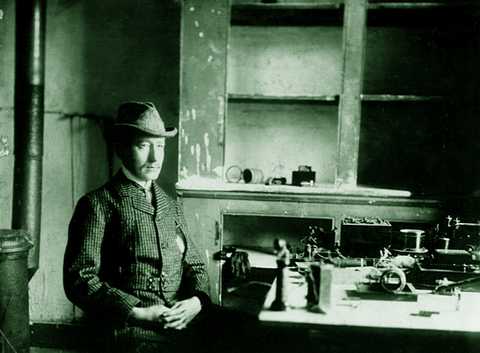
Several themes are used in the commemorations that highlight the historic achievements of Marconi, such as the contrasting technologies used in global communications and the innovative skills and high degree of technical competence of the traditional radio amateur operator.
Marconi himself participated in an event to mark the 30th anniversary of the first transatlantic wireless signal. He was in London at the time along with Kemp and Paget, according to the information in "My Father, Marconi" by Degna Marconi.
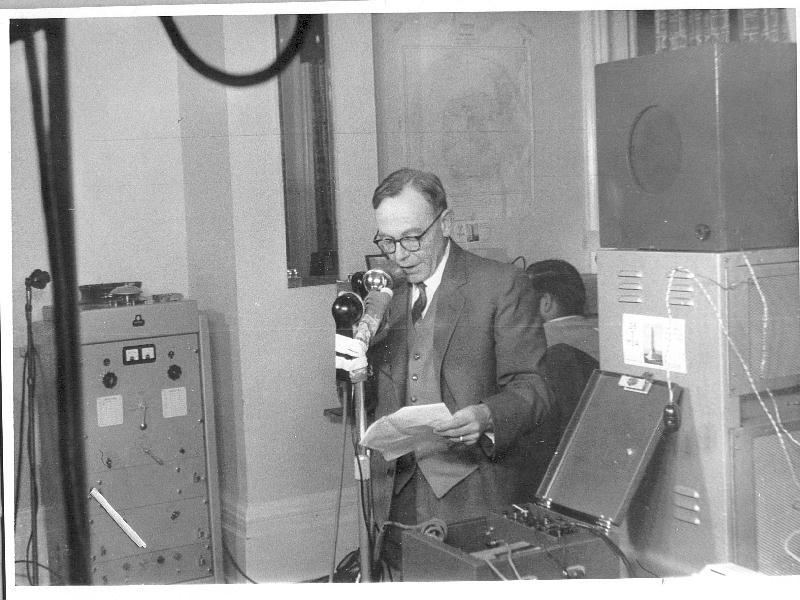
The 1961 operation took place from the Colonial building on Military road.

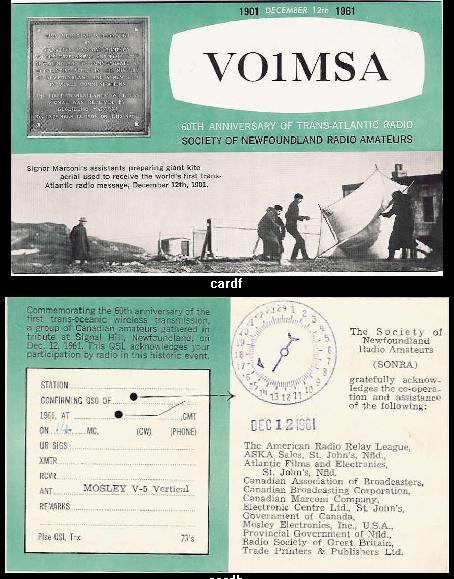

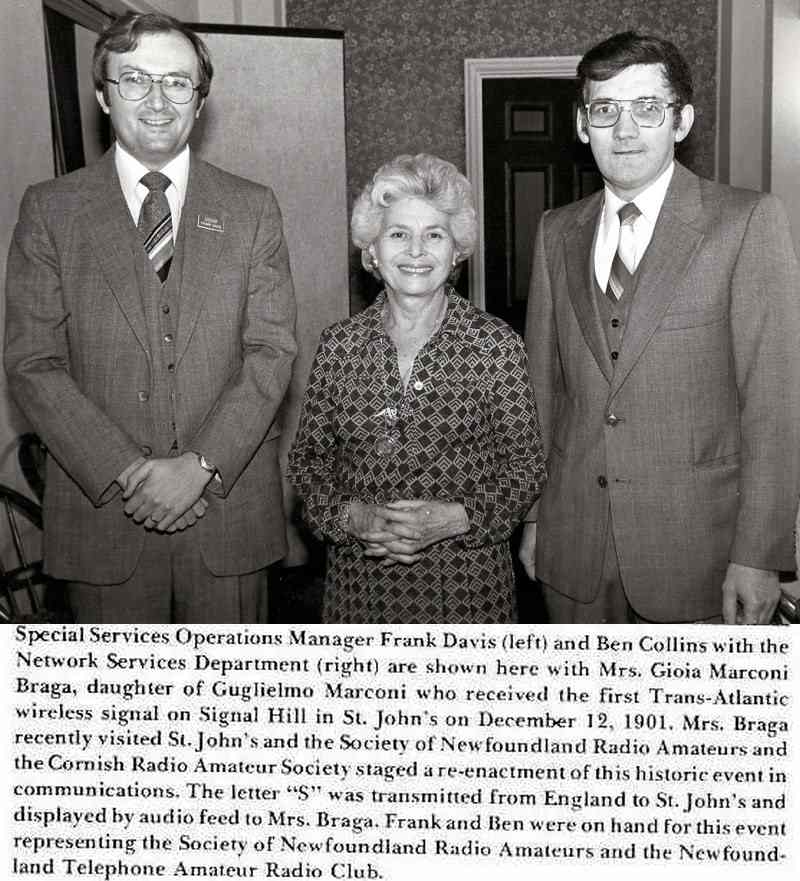
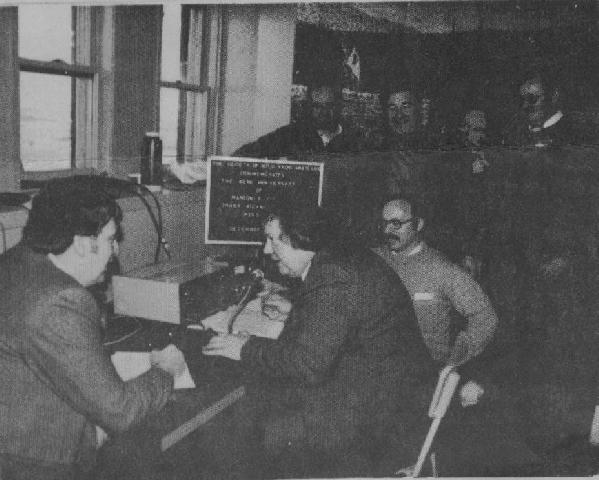
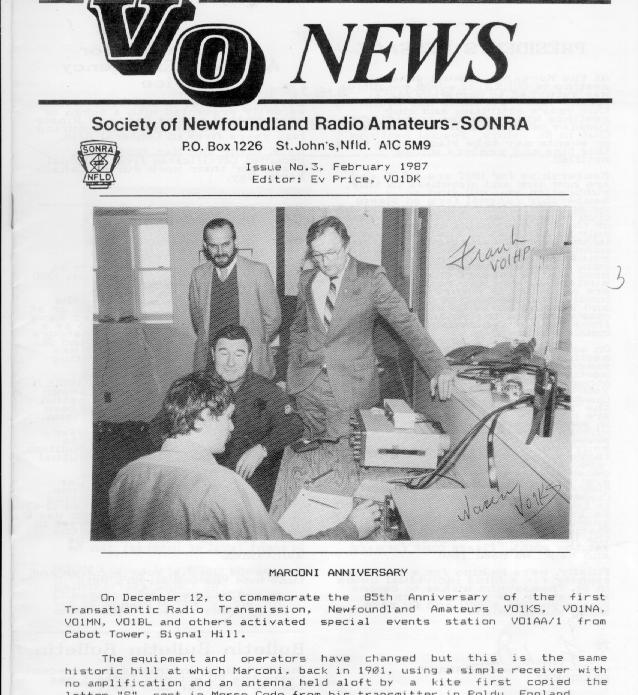
Mr R. Troke of Parks Canada (upper left) assisted and welcomed us to use Cabot Tower for the event.
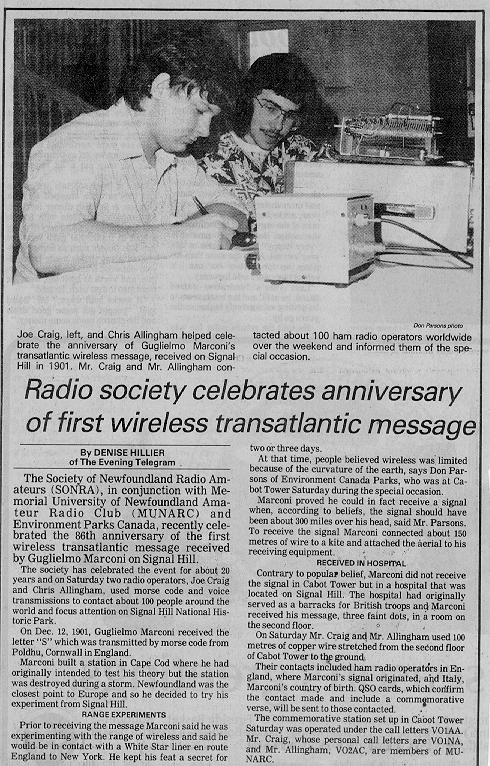
An operation was set up within metres of where Marconi heard the first transatlantic signal to commemorate the 90th anniversary. The operators were VO1KX, MP, and NA and several others. A re-enactment was conducted where the Morse letter 'S' was received from the Poldhu Amateur Radio Club in Cornwall, England.
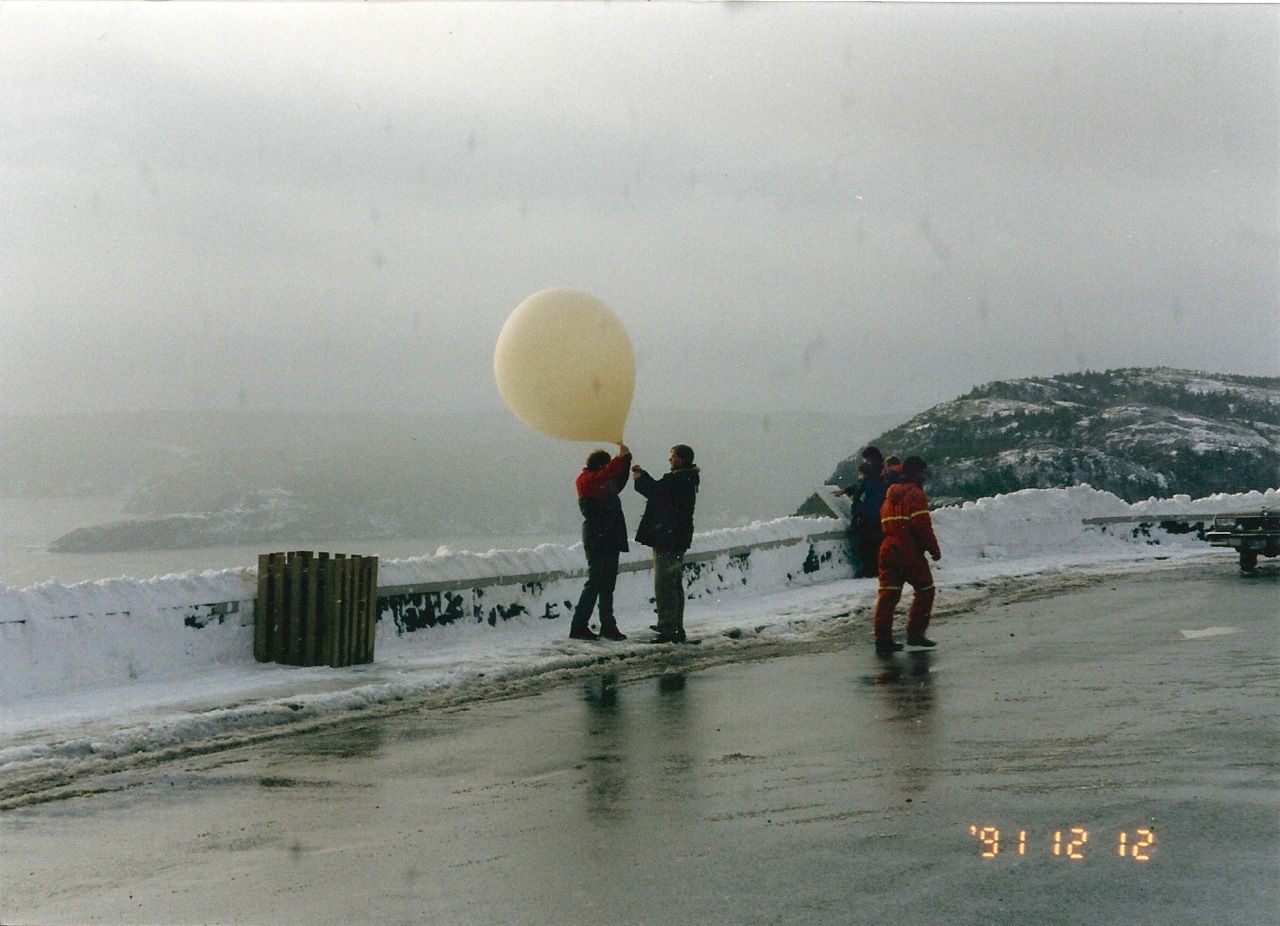
John Walsh VO1MR(sk) (hooded parka) assisting Eric Salter VO1KR fly a ballon supported long wire "Marconi" antenna on Signal Hill Nfld. Dec 12 1991. (Thanks to Frank VO1HP who provided this in 2013)
Plans to prepare for the 100th anniversary are discussed with Parks Canada
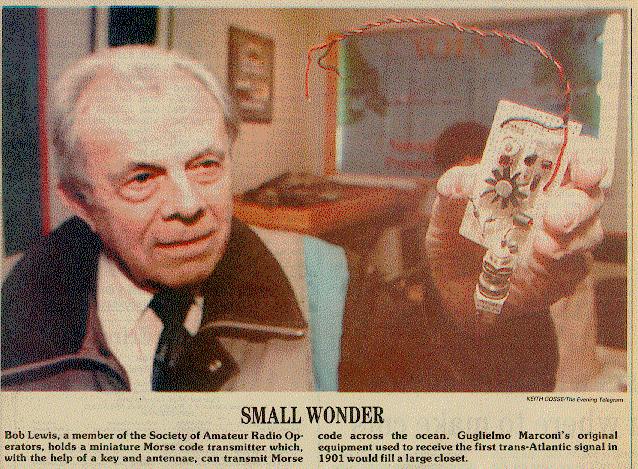
Operators were VO1JOH,VO1FE,NA,FZ and others.
Radio amateurs welcome Prof Len Zedel of the Physics Department of Memorial
University who has requested we attempt to make a direct contact with David
Edwards in Hobart, Tasmania on the other side of the world. Tasmania was the
site of a Marconi station in 1905. A special antenna is designed and a
prototype erected with the assistance of Parks Canada and the contact is made.
Greetings are exchanged between officials at CSIRO (VK7RO) and MUN via Morse
code and the internet. The Poldhu contact is established at 12:30 local time
and greetings are exchanged.
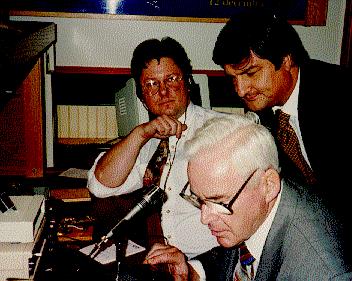
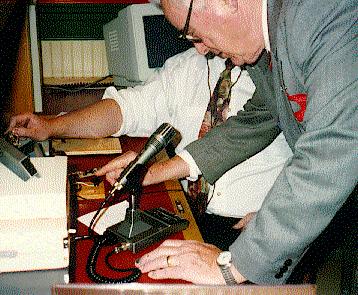

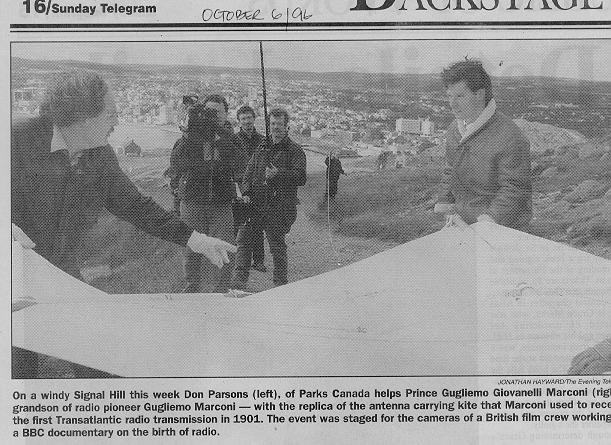
Contacts are made with Hobart via radio station VK7UJ and via internet phone. A message from David Edwards is sent from VK7UJ to VO1AA to be forwarded to GB2GM in Poldhu. Contact is established with Carolyn Rule in Poldhu and greetings are exchanged using radiotelephone. Home built radio apparatus is used to transmit messages in Morse code to Poldhu, including the letter 'S'.
On 2 October 1998, Mr Roy Dodge, VO1XP and Mr J. Craig VO1NA were very honoured to communicate with Princess Elettra (Marconi's daughter) while she was in Poldhu England. The Poldhu Amateur Radio Club had organised the event and the Newfoundland Telephone Club station VO1NT was used to communicate from St. John's. Also heard were amateur radio operators in Villa Griffone where Marconi did his early experiments. Click here to hear Elettra Marconi's radio transmission across the Atlantic from GB2GM (Poldhu) to VO1NT (St. John's).
Again, we are successful in contacting Poldhu and Hobart on 12 December. This year, Len and Autry exchange internet video and audio with Hobart. Radiotelegraph contact was established with Hobart. The small transmitter is used to send messages to Poldhu. Radio amateurs in St. John's chat with amateurs in Poldhu.
Prof. Zedel, David Edwards (Tasmania) and Mr. Craig are interviewed by CBC radio. A telegram is sent via Morse code to the Governor of Tasmania from the Lieutenant Governor of Newfoundland. Contact is made with Poldhu, but radio conditions are very poor and Morse code was the only reliable means of radio communication that was available.

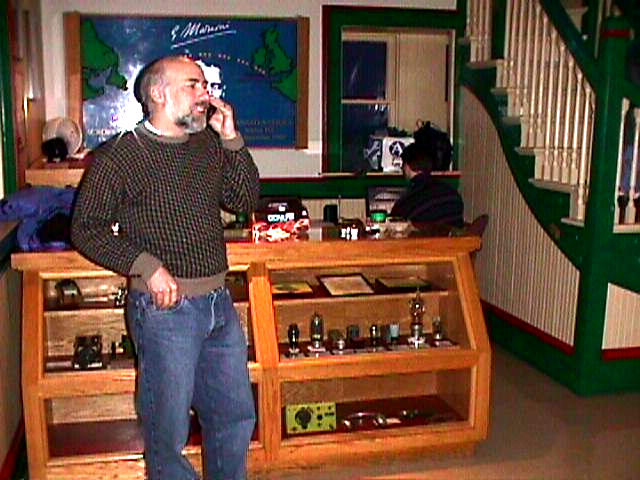
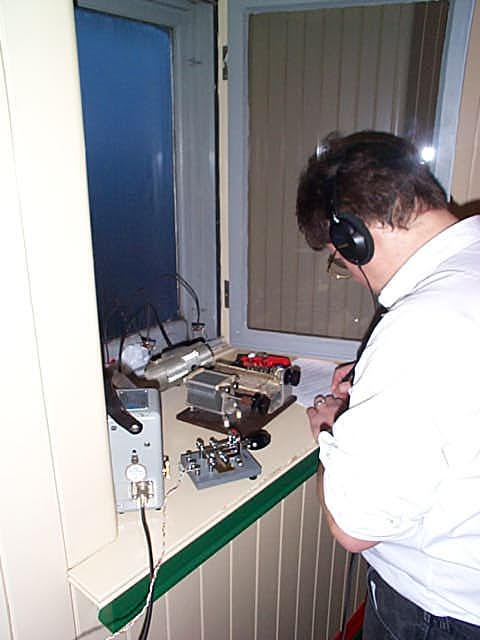
As in previous years, and following the tradition started by Marconi in 1901, we brought all of our gear to Signal Hill and set it up for the event. The aerial was tuned using a remote controlled balanced antenna tuner, constructed entirely from parts provided by the Canadian Marconi Company. We are very grateful to Mr Barry Hayes of CMC Electronics for his expertise and helpful technical discussions.
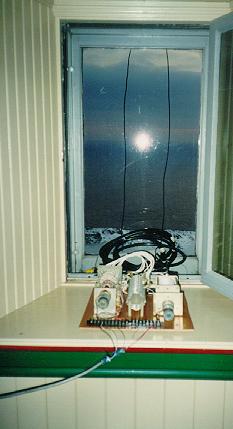
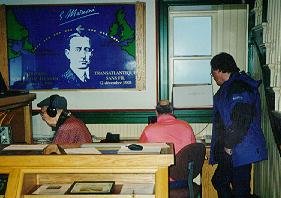
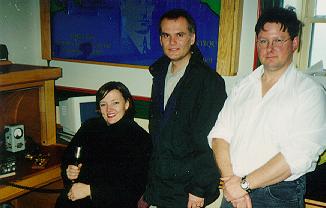
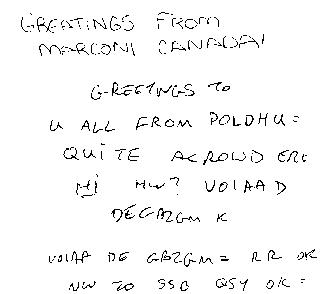

After considerable planning involving the Poldhu ARC, Memorial University and the IEEE, the Nfld Science Centre, Radio Amateurs of Canada and a host of others, we set up on the campus of Memorial University using half the driven element from the 20 metre yagi beam of VO1FB as a quarter-wave monopole atop the Music Building. The special call sign VD1GM was used. Telegrams were sent and received from government officials, radio amateur officials and academics. We were joined on the air waves by distinguished radio scientist Dr John Belrose and RAC regional director Bill Gillis VE1WG.
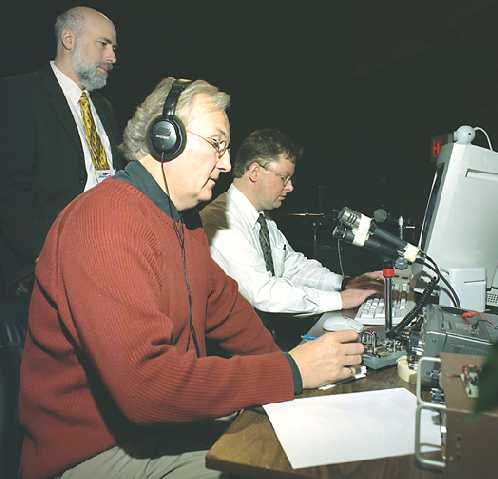
Photo: Chris Hammond, Memorial University of Newfoundland Photographer.
Dr Zedel looks on as Frank Davis, P.Eng operates the radio and Joe announces the transmission over the World Wide Web.
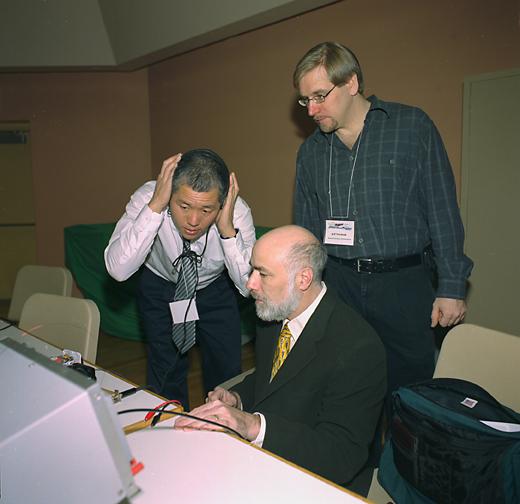
Photo: Chris Hammond
Drs O'Young and Zedel listen on a crystal receiver. This receiver was assembled by components contributed by several MRCN members. Jeff Newhook a senior electrical engineering student, looks on. The Receiver Competition for grade 9 students was a resounding success.
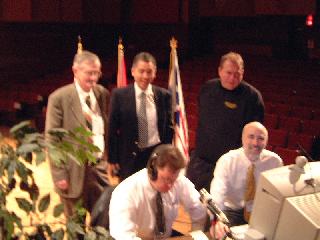
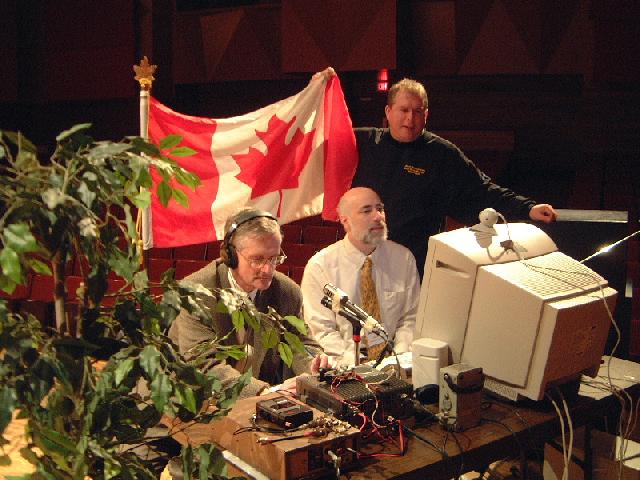
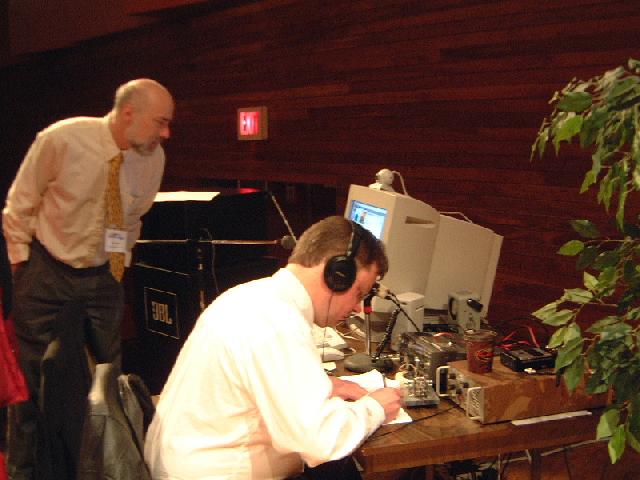
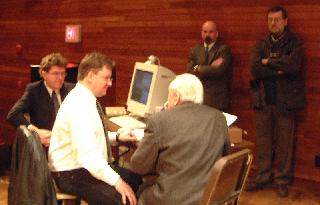
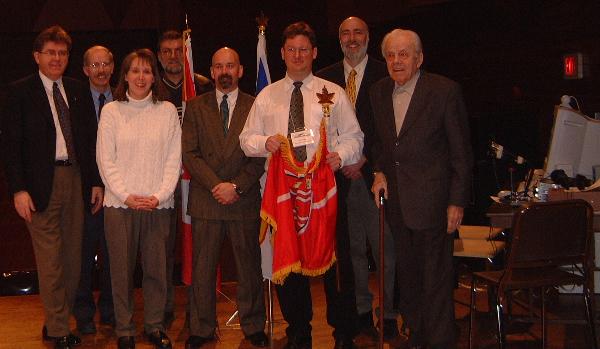
For additional details on the centenary events, please see the
Fall 2002 issue of "The IEEE Canadian Review".
Click here to hear the 'tiny transmitter' send the letter S and GB2GM, the call sign of the Poldhu Amateur Radio Club from Poldhu in September. Following the big splash on the Centenary, we resumed more usual operations. Contact was made with David Edwards via Richard Rogers by radio. Richard was pleased to accept an honorary membership in MRCN during the Morse code contact. David has also accepted an honorary membership.
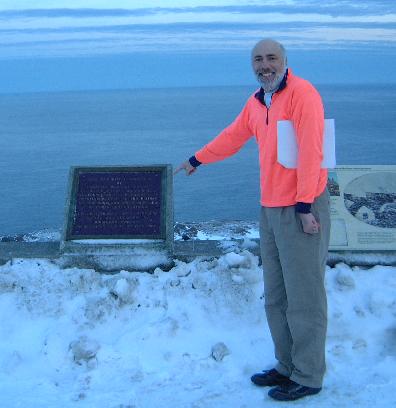
MRCN returned again to Signal Hill to successfully link the antipodes via radio (although not with Hobart) and to re-enact the first wireless transatlantic experiment. We used the telephone line and the internet to contrast with the radio methods of communication by contacting the ITRE in Hobart as part of their Radio Foundation Day celebrations. During our contact with Poldhu, MHA Jack Harris was greeted by his counterpart Chairman Carolyn Rule. We are very grateful to Michelle Miskel and the staff of the Johnson Geo Centre for their being so accommodating and arranging an interview with the local television station.

This year, we had the participation of all honorary members, Dr J. Belrose, Magistrate C. Rule, Mr David Edwards and Mr R. Rogers. Dr L. Zedel of MRCN was a guest at the radio station of J. Craig where 1 kW of RF on 7 MHz was transmitted from a 25 metre tower and gave readable signals in Hobart. Although VK7AW (VK7RO at the key) was very weak in Newfoundland, we did complete the contact on the 10th of December as part of an awards banquet in Hobart. Details appeared in the February 2005 issue of "Engineering Tasmania." We also sent images to Hobart and had a chat on the phone. And as usual, members of the Poldhu Amateur Radio Club and the Marconi Club linked again and reminisced about our many transatlantic wireless exchanges of greetings and members.
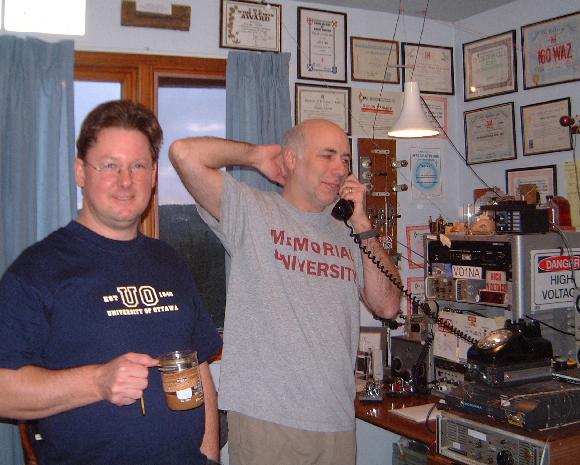
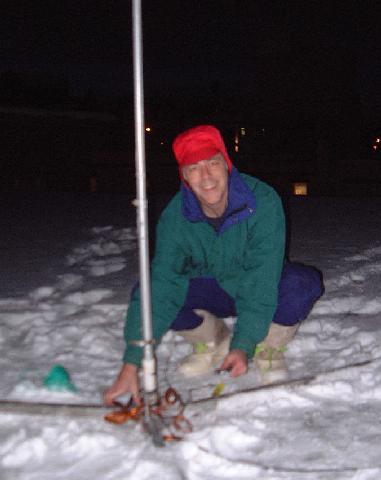
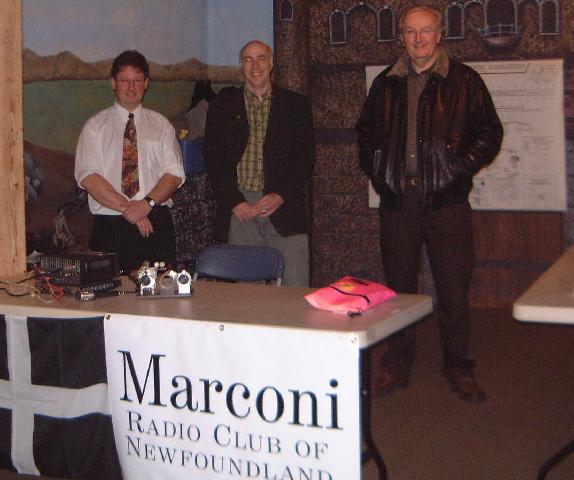
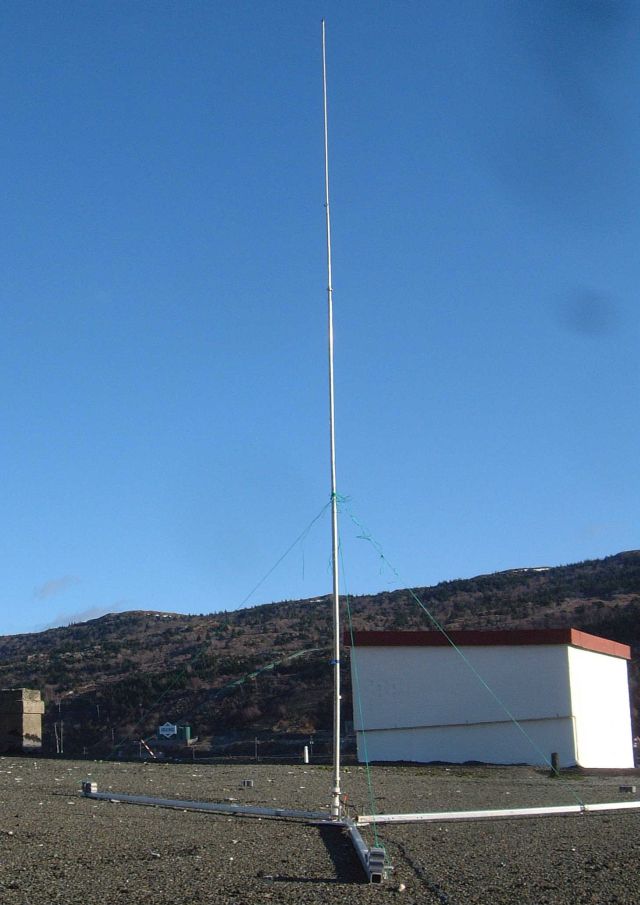
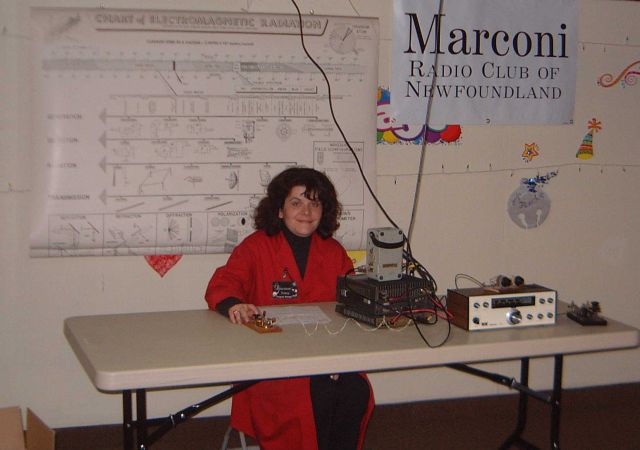
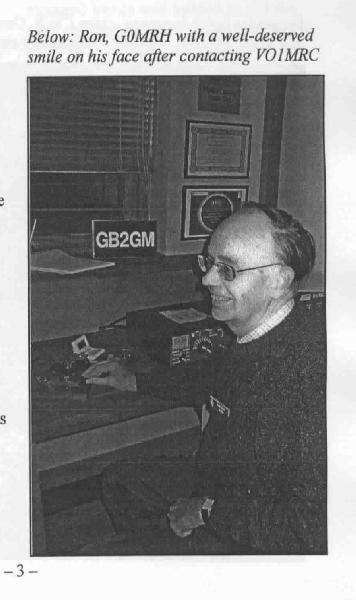
12 December 2007: Len and Joe contacted Hobart by Internet and Poldhu by radio on the 106th anniversary of Marconi's anniversary. A few dozen contacts were had as VO1MRC took to the airwaves after our contact with GB2GM. It was good to hear our honorary members David Edwards and Carolyn Rule.
We had hoped to return to Signal Hill for this event, but this did not happen. This was fortuitous as conditions were very poor and we had more power from a big Marconi transmitter at Joe's home station which meant we could maintain contact and exchange messages which would have been impossible from the hill. In anticipation of the poor conditions, we made initial contact 2 hours earlier 20 metres, then moved to 17 metres. Keith and Davey were in Poldhu and Joe was near St John's. We sent a Morse code telegram to mark 50 years of Parks Canada on Signal Hill. Best wishes were exchanged between MRCN and PARC amidst the deep fades and dirty key contacts at VO1MRC. At 1600 UTC, contact was established between G3AGA, Davey, and VO1MRC to advise that Poldhu was on 20m. We resumed the contact with GB2GM and received an acknowledgement of our telegram "Thanks to Parks Canada for the kind message" Best regards were sent on behalf of Frank VO1HP and Len who was unable to join us. Regards were relayed on behalf of Carolyn along with her regrets for being away at the time. It was often necessary to make several efforts to get messages across because of the poor conditions which were exacerbated by precipitation static from the snow in Newfoundland.
This year marked the centenary of Marconi's receipt of the Nobel Prize in Physics. This years participants included G0WYS and G0RJH from PARC and VO1FB VO1HP and VO1NA from as outlined in Keith's article in the PARC Newsletter 63, No. 1 March 2010.
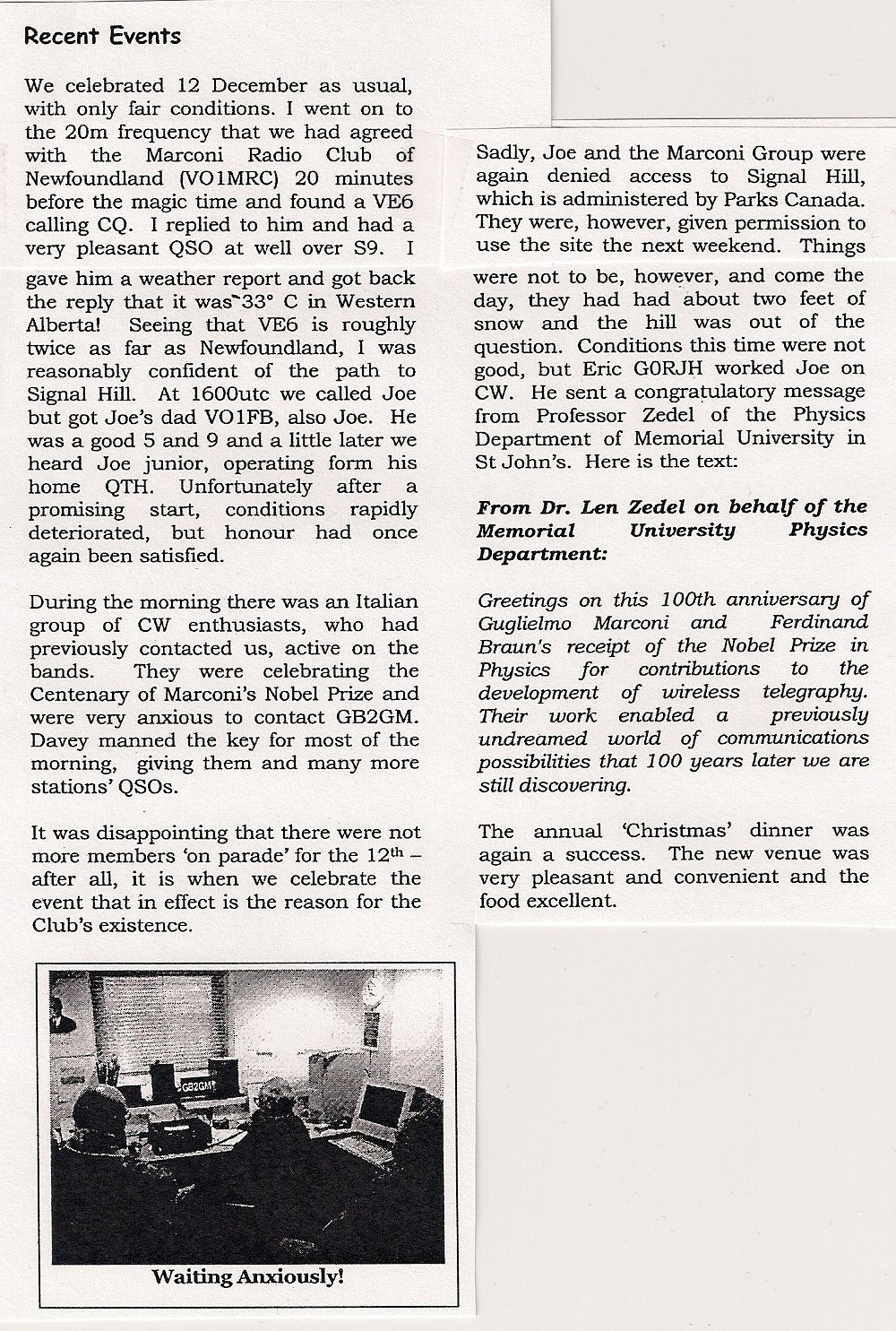
Once again, activities on the big day are outlined in an article in the Poldhu Newsletter 67, No.1. Thanks to Keith G0WYS (editor) and Joe VO1NA (author).
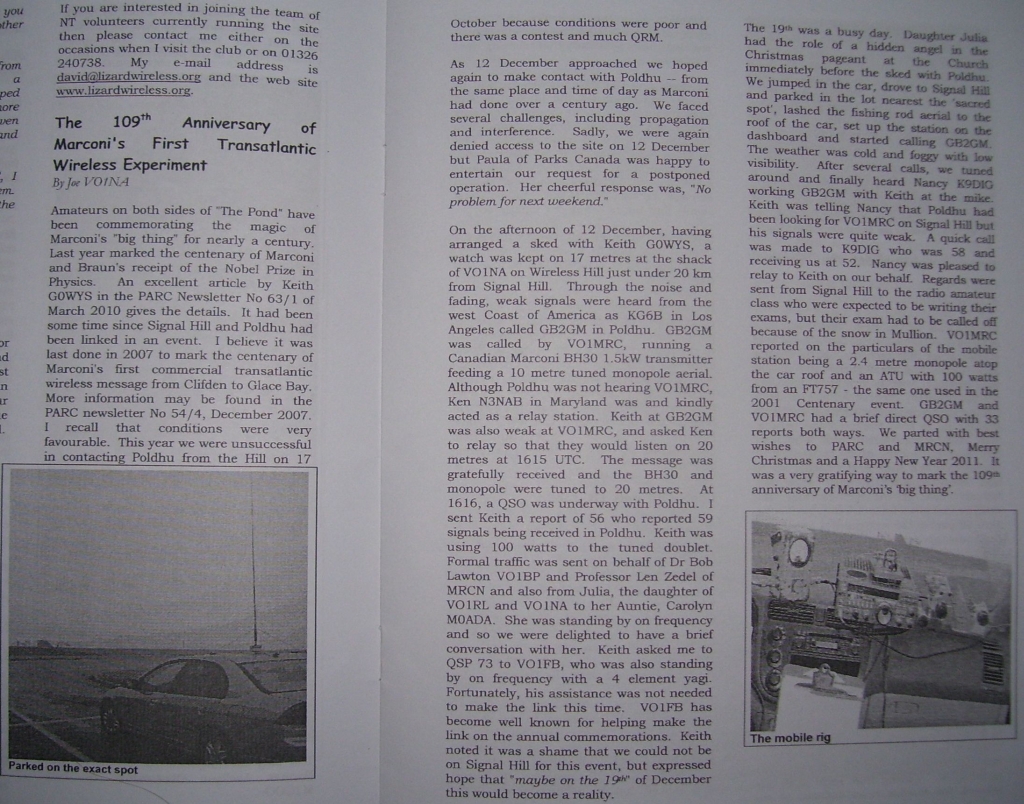
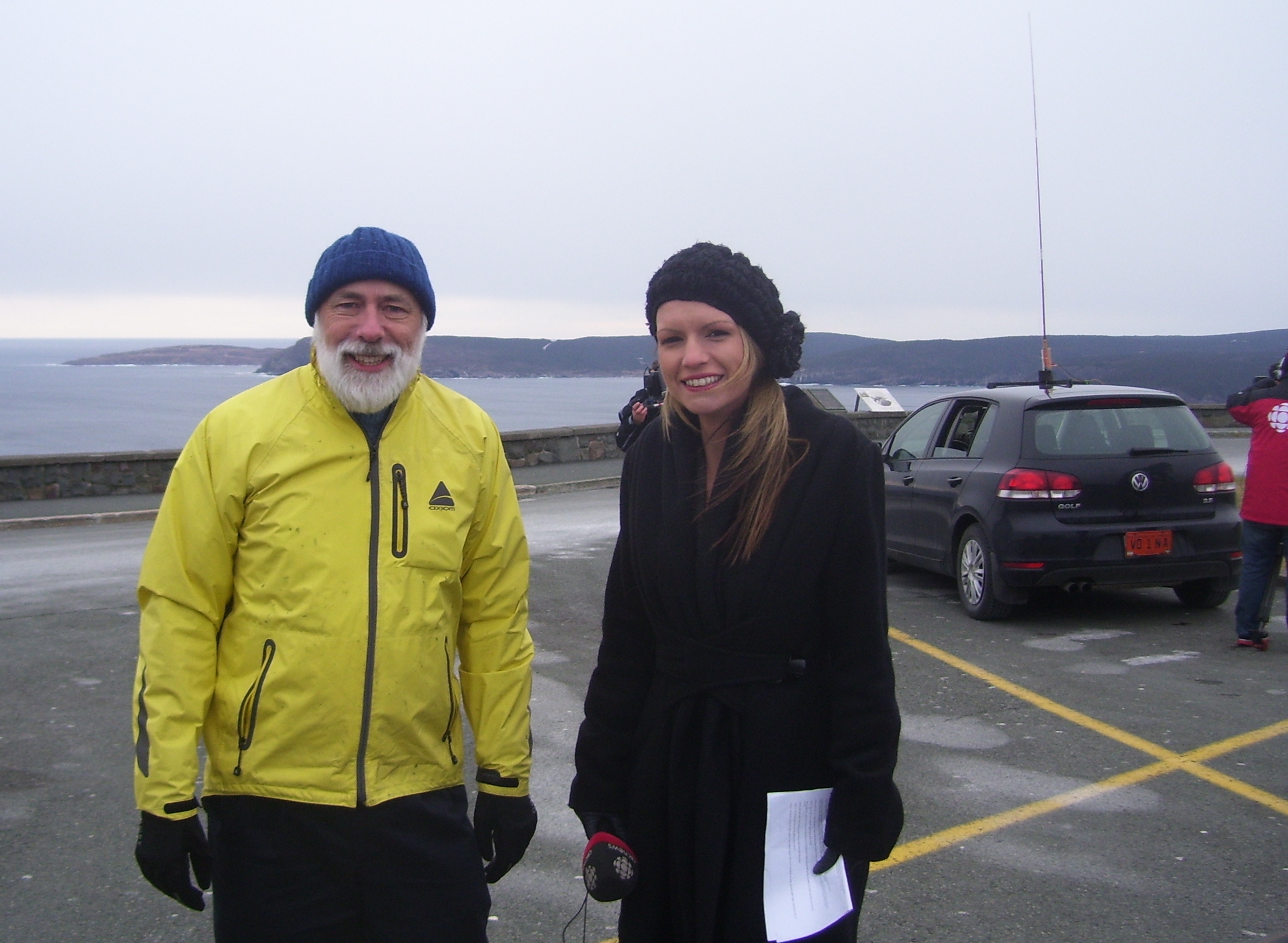
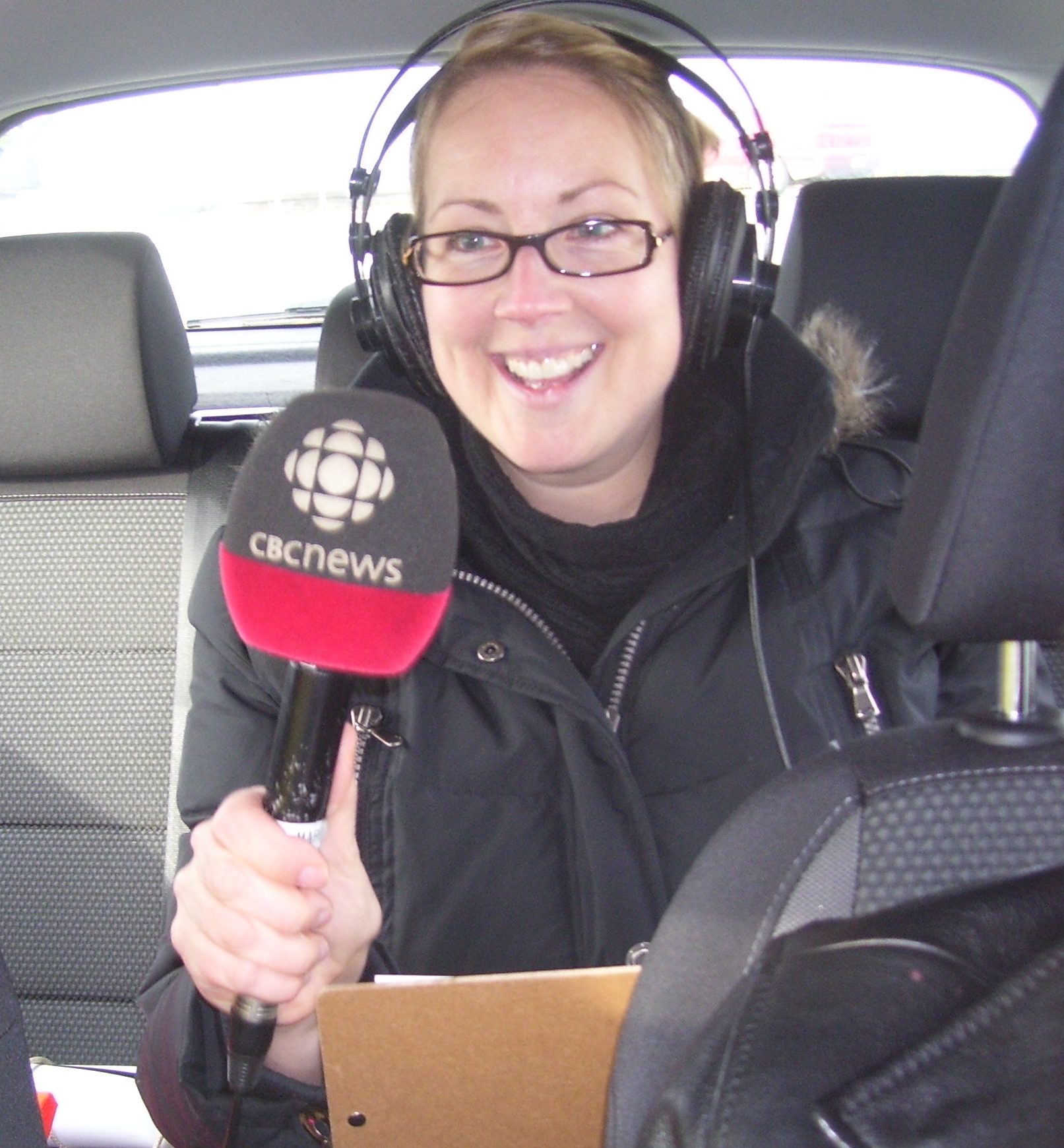
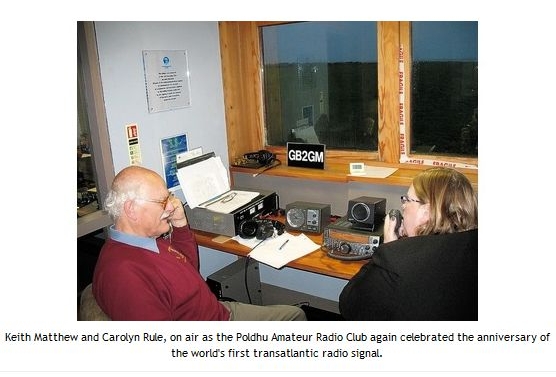

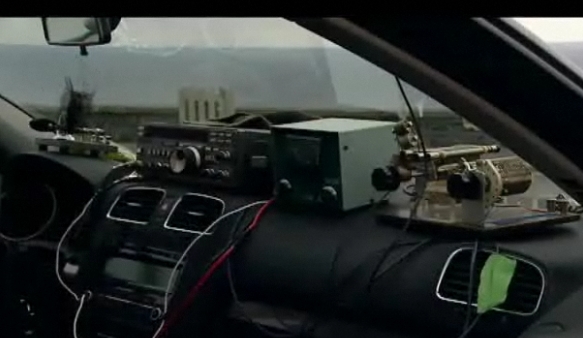
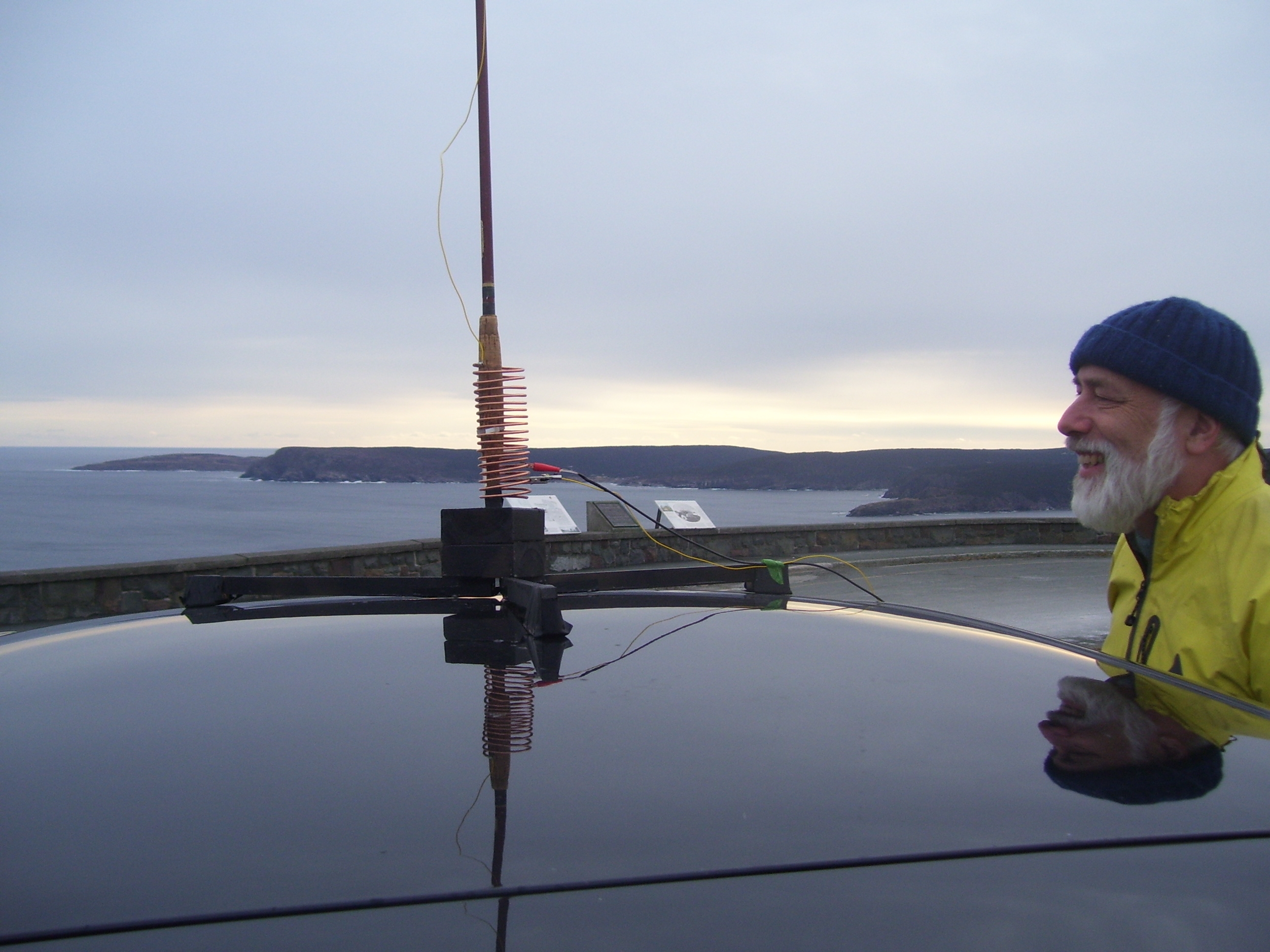
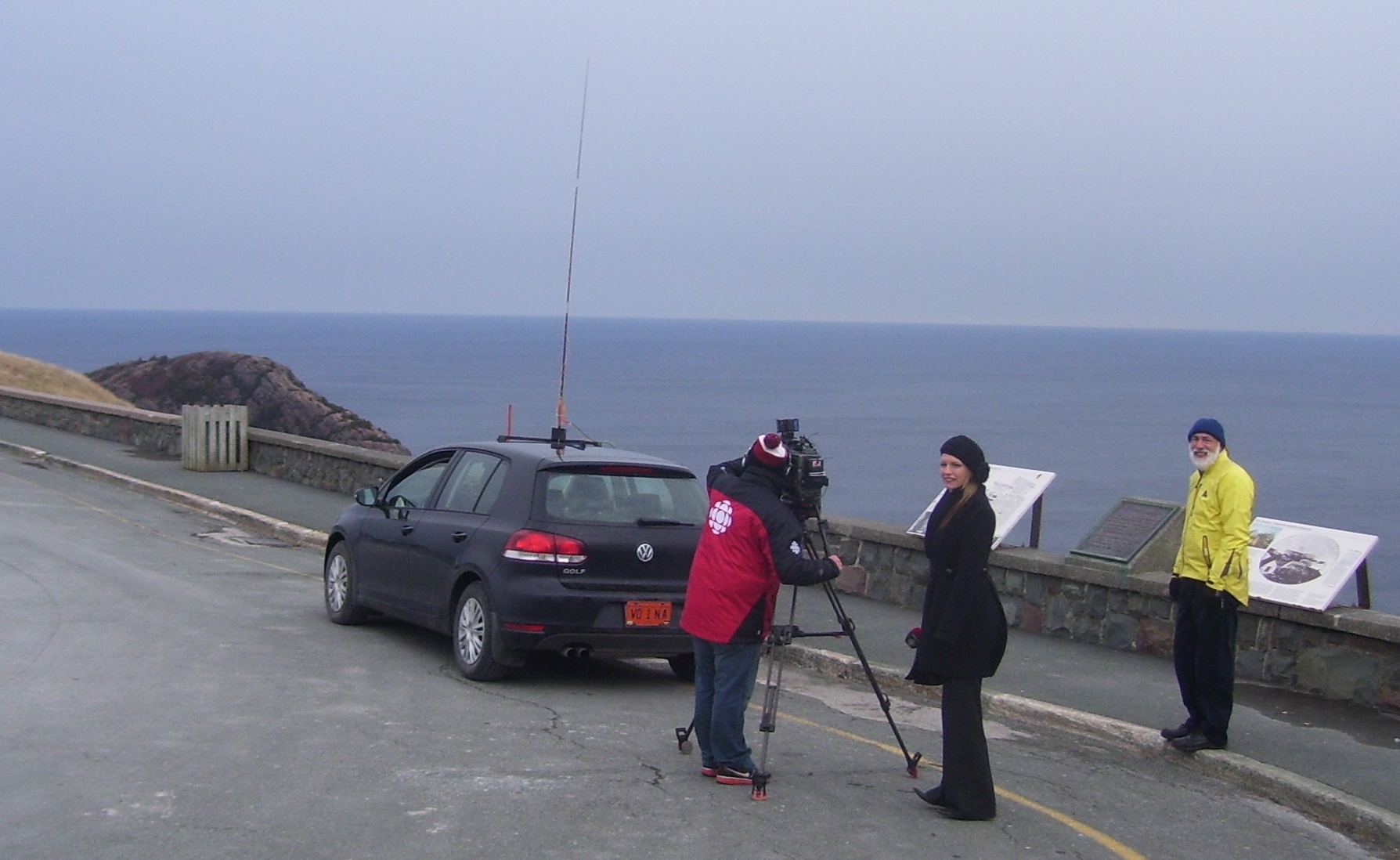
2012 - The 111th Anniversary
Ken and Joe return again to Signal Hill for our annual linkup with Poldhu. We are joined on the air by VO1FB, VA1VAS (Glace Bay NS) and KM1CC (Cape Cod MA) Several other stations were contacted using Morse Code from the parking lot.
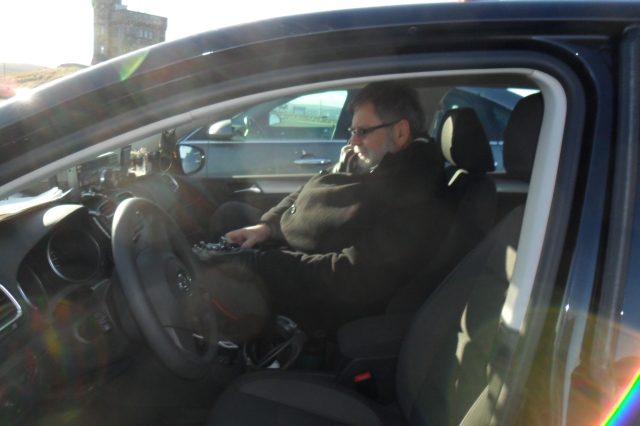
In the late fall, excitement builds on both sides of the pond. Cliff G3UYN publishes an item in the Poldhu ARC Newsletter on the 'Glorious 12th' and Keith G0WYS makes preparations. VO1FB and VO1XP are asked to keep a radio watch as the station is set up atop Signal Hill. At 12:30 Keith at GB2GM is heard loud and clear calling VO1MRC. Following some tinkering and adjustments with the transmitter in the car, greetings and telegrams are exchanged between Poldhu and Signal Hill, including kindest regards to Carolyn M0ADA and greetings were relayed from Len Zedel. VO1HP joined us on the air from his home station. Keith reported that there were new amateurs at the Poldhu club headquarters who were amazed at how the signals could have originated from a car across the ocean. There was a brief media spot on CBC radio that evening and VX9MRC was on the air, making contact with KM2KM, Kris in Ithaca, on 5348 kHz.

A curious VO1IRA is welcomed and comments on the strength and clarity of the Poldhu signals.
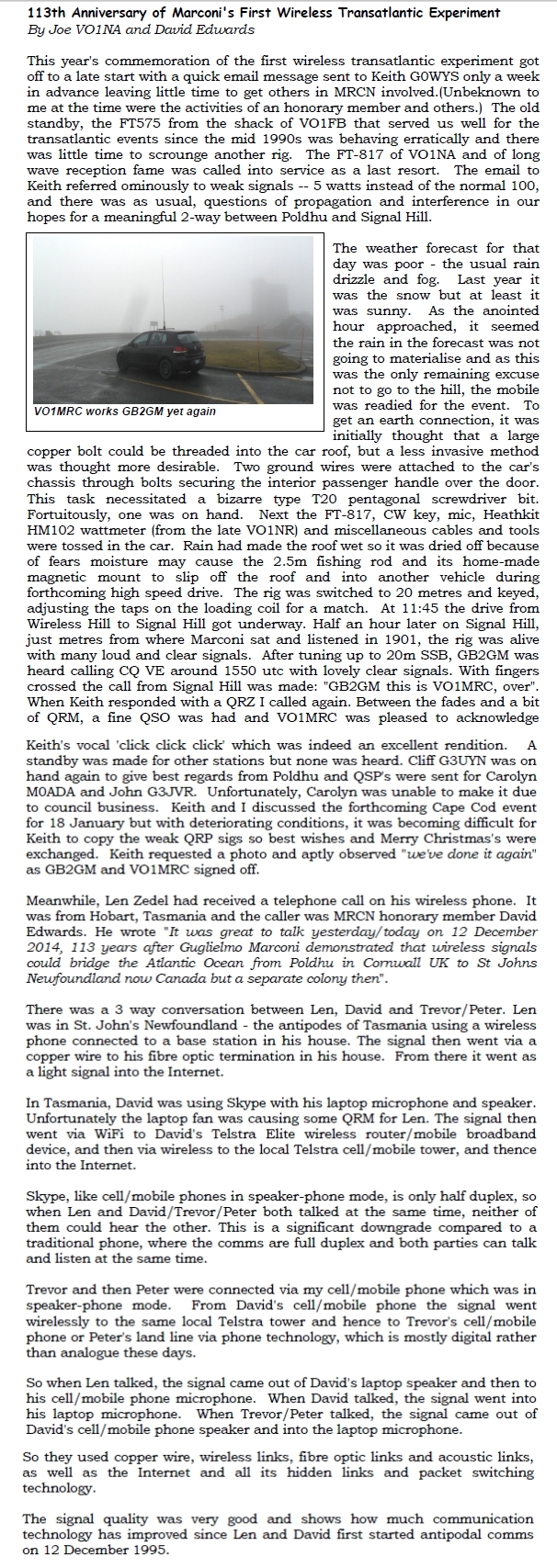
After a physics seminar at Memorial University in the fall of 2015, Len mentions 12 December and some ideas are tossed about.
Meanwhile experimentation on long waves is underway. A BPSK mode called EbNaut created by Paul Nicholson is used to send a telegram to Domenico IZ7SLZ in Italy from NL. The message "MARCONI 114TH ANNIVERSARY" was received on a wavelength 2200 metres with a Shannon efficiency of 32 per cent. The assistance of DF6NM and Paul is gratefully acknowledged.
Keith, soon to be GK0WYS, finalises the GB2GM/VO1MRC sked for the 12th. By then, VO1HP and Joe who is wearing his PARC jersey, meet at VO1FB's for a VO DXCC Honour Roll photo by VO1RL. VO1FB generously makes his beam and rig available for the QSO. We call on CW using a 4 element beam and get excellent reports both ways. Condolences are expressed to our long-time friend Carolyn and we understand why she was not joining us. Keith mentions that Andy G4JNT, who also received the long wave telegram, built the 1.9 MHz beacon used for the 2006 Marconi experiment. Keith then sends the "S" and we receive the three clicks. Gratified, we tried modern technology. Although the batteries on the cell phone failed, VO1HP had another handy so we could call Len at home. Len sent greetings from MRCN to PARC over the radio link to Poldhu. We recalled the visit by G7FOT of PARC to VO land last summer. GB2GM remains the air to make more contacts while VO1MRC goes on to work 20, 40 and 60 metres to make more contacts including IZ2PKD in Bologna.
From the Poldhu Amateur Radio Club Newsletter 92,2, June 2017, p 11.
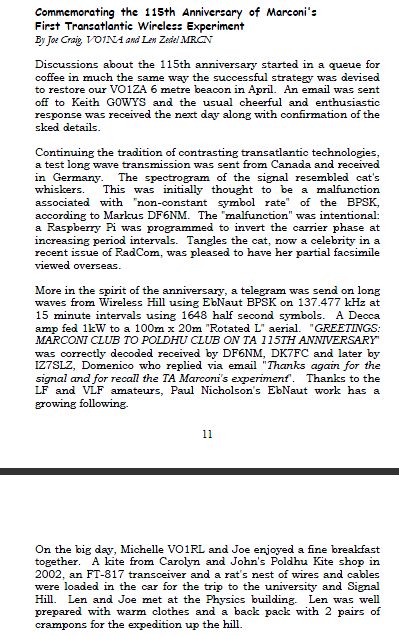
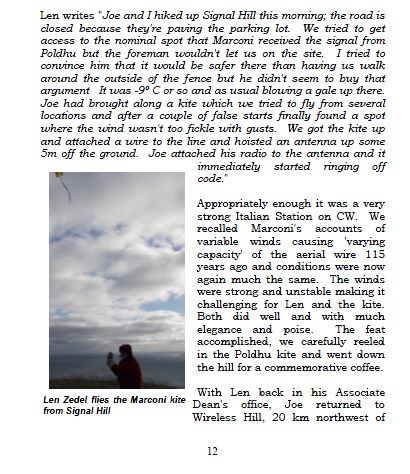
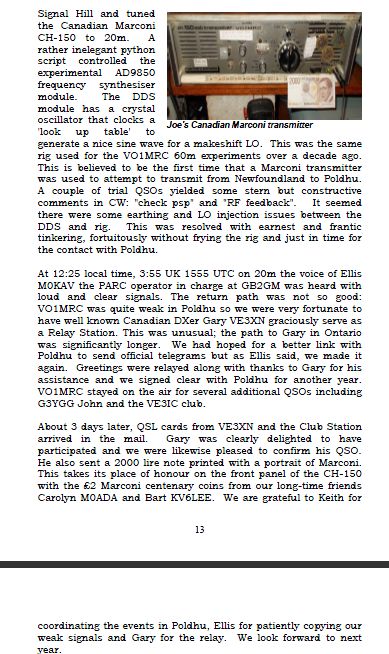
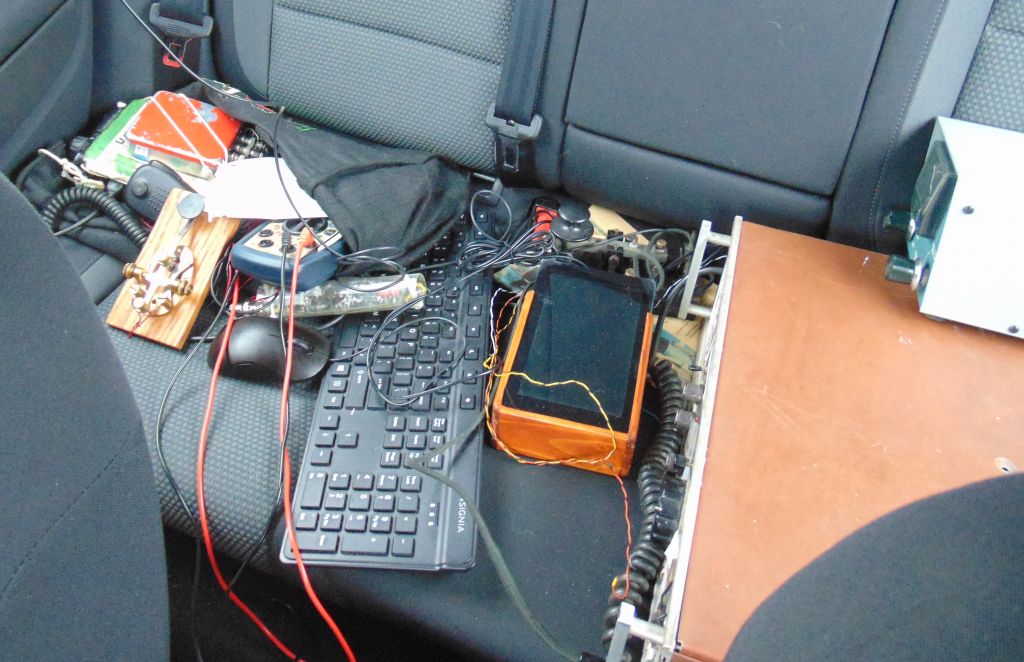
The back seat: radio gear for a 2-way Atlantic span expedition.
Len summits Signal Hill with Joe to provide vital assistance such as orienting the SWR meter during antenna tuning, becoming an impromptu spokesman for curious visitors and other related tasks as Joe battles malfunctions and poor conditions brought on by low sunspot numbers. Keith describes the event (PARC Newsletter 95,1, March 2018, p 6.)
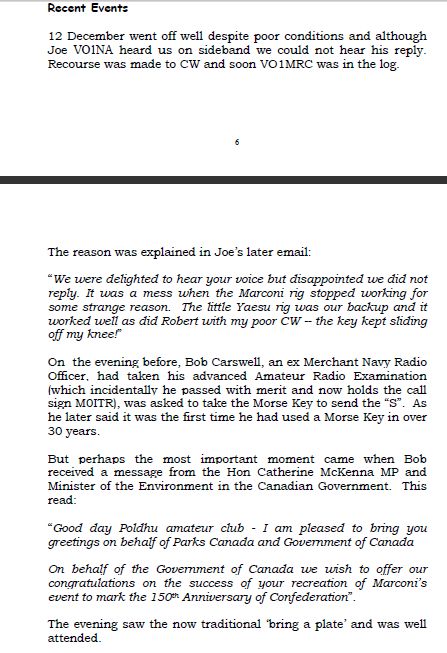
As usual, we started by exchanging email with Keith G0WYS a month beforehand. On the 12th, radio conditions were poor and the weather was not much better with the snow. Len and Joe meet on Signal Hill and installed the VO1FB fishing-rod antenna on the roof of the car. We made contact with a station in the US but could hear only faint traces of signals from Poldhu, but no reply to our calls on SSB or CW. Better luck was had with VLF transmissions from Wireless Hill 20km away. The message 'POLDHU MARCONI 73PARC' was received on 8.27 kHz in Europe.
2019 The 118th Anniversary
Things got off to a late start last fall. Because Joe VO1NA was engaged in academic matters, there was little time to prepare for the commemorative contact. As usual, Keith G0WYS had done his part in coordinating the QSO with a cheerful email. Len Zedel and Joe had hoped to install a portable station at the university by stringing a wire from a physics classroom window and sending telegrams to Poldhu. Unfortunately, since the last such operation, these rooms had become labs and offices. By now, the physics head, Kris, WO0H felt it was a bit late to make alternate arrangements so Joe offered to activate VO1MRC from Wireless Hill 20 km to the north of Signal Hill.
On the evening of the 11th, an LF transmitter was activated to send the message 'MARCONI' using a BPSK mode known as EbNaut on 137.477 kHz. By the morning it had been received at DF6NM, DL0AO and fittingly by IZ7SLZ in Italy. Joe was cautiously optimistic on the morning of the 12th, considering the reliability of the 10m (half wave) monopole, the absence of sunspots and solar flux of only 71. Despite this, many callsigns were in the log that morning including a CW QSO with GB2GM. As 1600 ut approached, there was a VE3 on QRG, but GB2GM could be heard 1 kHz up. It was Cliff G3UYN and later David G3PLE who were loud and clear on the TS590 at VO1MRC. Once contact was established at 1600ut, the letter S was sent and recorded. Telegrams of greetings sent from Len and Siu on behalf of the their academic units. David relayed Keith's regrets for being 'under the wx' and Joe, hoping this was minor, asked to relay his wishes for a speedy recovery.
2020 The 119th Anniversary
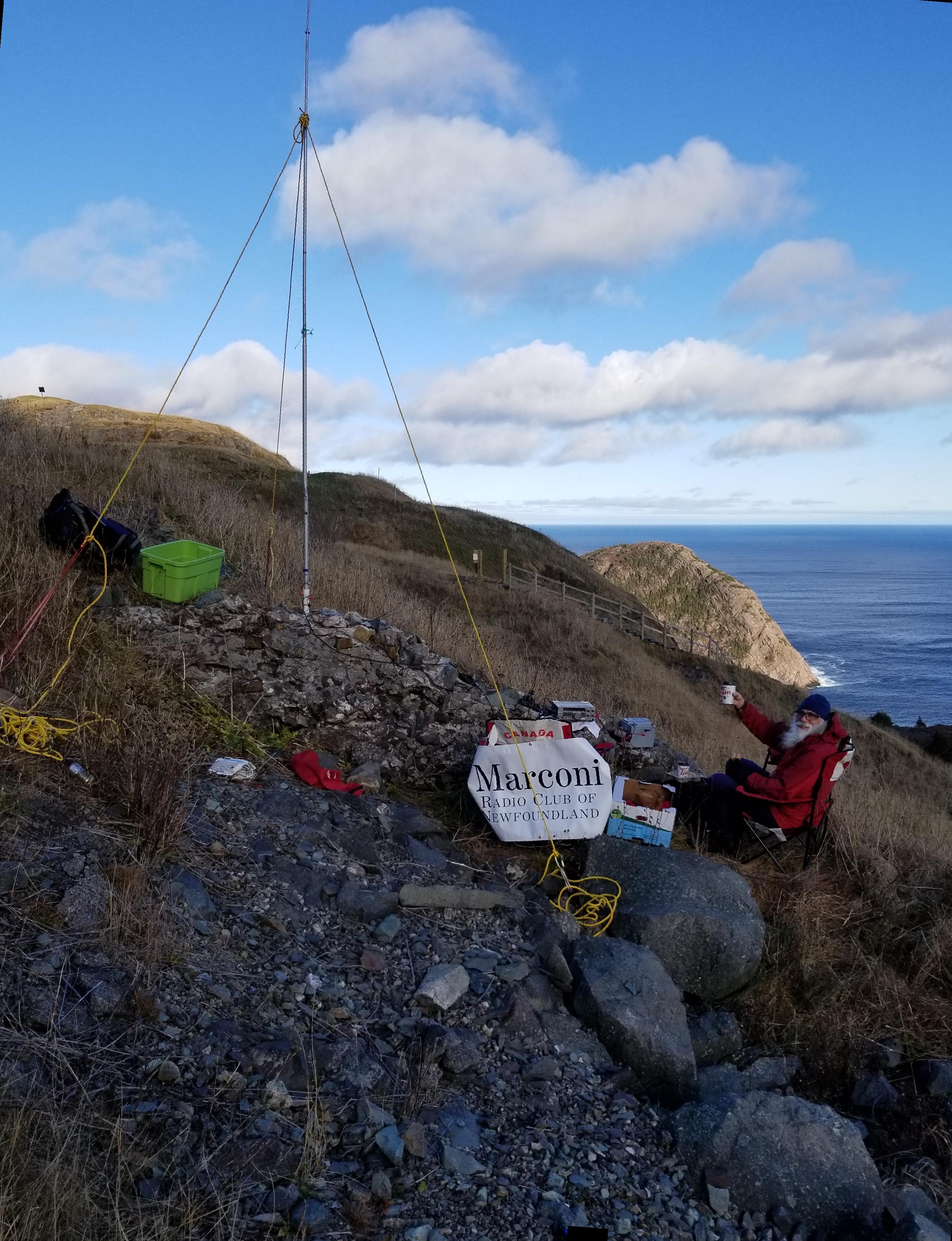
The plan was set up on on the ruins of the fever hospital where Marconi, Kemp and Paget listened in 1901. We shared the idea with Parks Canada without objection and meet on the very spot around 11:55 am and raised the quarter-wave monopole using ropes, slings and other rock climbing accessories. Len brings a battery and deploys radials as Joe connects the VO1FB TS-440S transceiver. We were ready at 12:30 and heard many strong signals including a station in Ireland. We called him but he reported hearing only distortion from us. The battery had failed. An April retry for International Marconi Day 2021 saw better fortune and an excellent exchange between GB2GM and VO1MRC with tributes to Keith, G0WYS and his outstanding contributions to the re-enactments over the past 2 decades.
2021 The 120th Anniversary
Feel free to include a link to this web page, but please note that no material may be copied from this site without the prior written permission of the authors and acknowledgement of the Marconi Radio Club of Newfoundland.